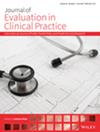Characterizing Personal Clinical Cognitive Uncertainty and Its Association With Clinical Judgment
Abstract
Rationale
Clinical uncertainty has been studied mostly in relation to clinical scenarios or as a personal characteristic. The intersection between clinical context and personal characteristics remains underexplored. Specific forms of personal and cognitive clinical uncertainty may exist at different layers of cognitive processes, and impact clinical judgment and training.
Aims and objectives
We aimed to characterize and quantify facets of personal clinical cognitive uncertainty, and examine associations with clinical judgment.
Methods
We recruited 120 learners and 24 supervisors at the Centre hospitalier de l'Université de Montréal. Learners completed 15 multiple-choice vignettes and recorded their level of uncertainty for each. Learners' characteristics and supervisor-rated clinical judgment were compiled. We quantified five uncertainty measures: self-reported general uncertainty, degree of clinical uncertainty, relative, absolute, and objective calibrations of uncertainty. Correlations between demographic characteristics, test scores, and uncertainty measures were computed. We examined adjusted linear regressions of clinical judgment on uncertainty measures.
Results
Mean age of learners was 24.9 years (SD = 3.5), 80 (68%) were women, 52 (44%) had undergraduate education. Mean test score was 61% (13) and supervisor-rated clinical judgment was 40 (10) over 60. Higher degree of clinical uncertainty correlated with lower scores, lower training levels, and being a woman. Higher self-reported general uncertainty was associated with higher degree of clinical uncertainty but lower relative and absolute calibrations. Higher test score was correlated with higher absolute and objective calibrations. Lower self-reported general uncertainty (standardized β = −0.27, p = 0.003), lower degree of uncertainty (β = −0.27, p = 0.01), higher relative (β = 0.16, p = 0.09) and absolute calibrations (β = 0.18, p = 0.06) were associated with clinical judgment.
Conclusion
We identified five measures of personal clinical cognitive uncertainty with differential associations with clinical judgment and knowledge. Greater focus on understanding and teaching of personal clinical cognitive uncertainty may enhance clinicians' tolerance to uncertainty and improve clinical judgment and outcomes.

 求助内容:
求助内容: 应助结果提醒方式:
应助结果提醒方式:


